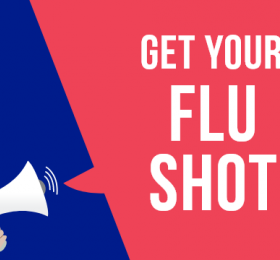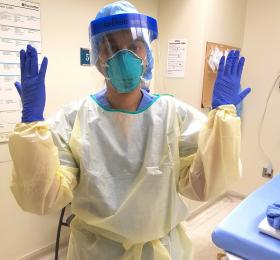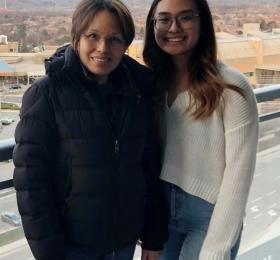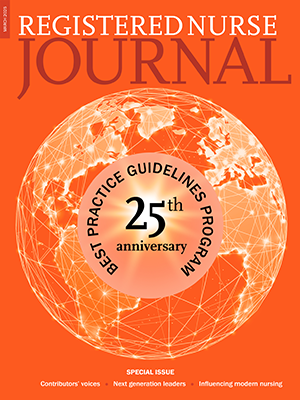Letter to the editor
RNAO board member Julie Rubel writes a letter to the Waterloo Region Record (Aug 9) about how long-term care residents should be allowed to visit with their loved ones.
It shouldn’t be this difficult to visit a loved one in a long-term care (LTC) home. But this is what Ontario families are experiencing as government protocols are interpreted differently by nursing home operators. It means some can visit up close while others visit metres apart, unable to hold their loved one’s hand.
We know the effects that shutting down LTC homes for months has had on residents. Intended to protect residents, restrictions were indeed depriving them of the love only families can give. Even now, some decline as they are denied the assistance loved ones provide with personal care activities like eating, toileting and exercising.
The looming second wave dictates we rethink how residents are reunited with their loved ones. We need a uniform approach that all nursing home operators are required to follow. Residents should have the right to identify up to three essential family care partners with no restrictions on how often or how long visits last, even during an outbreak. Personal protective equipment should be readily available and communication between families and homes must be regular and clear.
Nursing homes are people’s homes. Residents have a right to see their family. Let’s get this right.
UPDATE: In September, the Ontario government updated the visitor policy for long-term care homes. Essential caregivers are now allowed to visit any time, even during an outbreak, subject to direction from the local public health unit. Each resident can have two caregivers. As of Oct. 7, only essential visitors are allowed to visit loved ones in long-term care homes in Ottawa, Peel Region, and Toronto. Nursing homes in York Region were added to the list Oct. 19.
RNAO encouraging Ontarians to #FightTheFlu
Flu season is upon us. And this year it coincides with the COVID-19 pandemic. There is currently no vaccine for COVID-19, but getting a flu shot will help people keep their immune systems healthy. RNAO encourages everyone, especially health providers, to get their flu shot to help protect against influenza. It is also important to continue practising the public health measures that have been in place for COVID-19, including washing your hands frequently, maintaining physical distancing and wearing a mask as this will help stop the spread of both COVID-19 and the seasonal flu. RNAO has created a flu season portal, to provide information on where to get the flu shot and how to keep yourself, your family and your patients healthy this flu season. The portal is updated with credible resources to provide you with the information you need. To learn more, visit RNAO.ca/covid19/fight-flu
COVID-19: RN urges kindness, patience during pandemic
Toronto RN Eram Chhogala works in trauma and resuscitation. She has been on the frontlines during COVID-19 and notes that self care is vital at this difficult time. Nurses are “burned out” and “going through a lot of stuff,” she reports. Stresses such as family members being laid off, or issues with relationships and marriages, are overwhelming to a lot of people. This is why she tells others to “…be kind to one another, because everyone is fighting their own battle.” (Toronto.com, June 2)
COVID-19: RNAO launches #Maskathon
Wearing a mask can help fight COVID-19 and prevent a second wave of the dangerous virus, says RNAO CEO Doris Grinspun. “Nurses, doctors and other health professionals have already spoken out about the importance of wearing masks in indoor public spaces, and show that wearing a mask – on top of practising safe physical distancing and good hand hygiene – makes a difference,” says Grinspun. To urge everyone – including children and youth – to wear a non-medical mask or face covering in indoor public spaces, busy areas and transit, RNAO officially launched #Maskathon on July 14. Health professionals and members of the public are posting pictures of themselves wearing a mask on Facebook, Twitter and Instagram, using the hashtags #Maskathon and #TogetherWeCanDoIt. Those who do not have access to social media and would like to participate are invited to send a photo to maskathon@RNAO.ca. For more information, visit RNAO.ca/covid19/maskathon (BlackburnNews.com, July 14)
COVID-19: Mother-daughter duo work together during crisis
Monina Pajatin and her daughter Mia are emergency department RNs at Mississauga’s Credit Valley Hospital. They are relying on one another to get through the global pandemic. “I take it day-by-day,” says 20-year veteran RN Monina, who trained as a nurse in the Philippines before coming to Canada. Mia is a recent nursing graduate from Humber College, and looks to her mom for support as she launches her career during a difficult time for Canadians. Monina says patient safety isn’t always easy in times of crisis. “Sometimes, it is challenging to provide comfort (to patients)...I try my best to provide them with the appropriate information and health teaching to maintain their safety in the hospital as well as the community.” Despite this, Monina says nursing as a career is very fulfilling, and having a “positive impact on somebody else’s life when they may be experiencing one of the most difficult times is what inspires me the most.” (Mississauga News, May 31)
Palliative care during COVID-19
As an RN at Hospice Niagara, Mahoganie Hines is working on the frontlines during the pandemic to help those in her care have a good death, which includes efforts to ensure loved ones have a chance to say goodbye. This year, due to COVID-19, the number of people who can see their loved ones at the hospice is limited, and only designated visitors are allowed in the facility, one at a time. Hines says she and her colleagues have been helping hospice residents connect with their loved ones through videos, phone calls and window visits. “The family members that maybe aren’t their designated visitor, they can come visit at the window,” says Hines. “We’ll push the bed over to the window, so that way they can see them and that way they can hear them.” Hines has also been prioritizing comfort, including taking more time while giving residents showers and baths, and bringing them outside. “Even if they can’t get up, we can take them outside in their bed, so they can see the sunshine or smell the rain,” she says. (CTV News, May 31)
RNAO calls for immediate action in long-term care homes
To prepare for a second wave of COVID-19, RNAO CEO Doris Grinspun is calling on the government of Ontario to adopt several long-term care recommendations by July 31. In an op-ed in The Globe and Mail, Grinspun writes that during the first wave of the virus, there was a lack of early prevention measures and health-risk awareness. “Any preparation carried out was targeted to the already resource-rich hospital sector, leaving the other sectors to fend and fail for themselves,” writes Grinspun, adding there is no time to wait until April, when the results of the recently announced commission looking into how the LTC system responded to COVID-19 delivers its report. Included in RNAO’s recommendations to the government are calls to implement a Nursing Home Basic Care Guarantee that provides four hours of direct care and a richer skill-mix of regulated and personal support staff in nursing homes, ensuring personal protective equipment is fully available to all staff in long-term care and other facilities caring for vulnerable persons. RNAO is also calling for immediate and full implementation of the five-step plan proposed by RNAO for reuniting families in long-term care. In addition, less invasive surveillance testing, immediately isolating residents with the virus, and ensuring facilities have quarantine plans in place and single-occupant rooms have personal bathroom facilities. (The Globe and Mail, July 20)
Elective surgeries resume
Brantford General Hospital resumed elective surgeries in June, following months of these being put on hold because of COVID-19. Martin Ruaux, vice-president of clinical programs and chief nurse executive for Brant Community Healthcare System, says the surgeries resumed on a gradual basis, with the most urgent performed first. The plan was to start by working at 25 per cent of normal activity for two weeks, then ramp it up to another 25 per cent every two weeks, Ruaux says. Pre-pandemic, the hospital was performing about 42 elective surgeries each day. Those non-emergency procedures were put on hold on March 15. To resume elective surgeries, hospitals must ensure the number of COVID-19 cases in the community is stable. They must have a stable supply of personal protective equipment and medications, as well as a sufficient number of patient beds and appropriate staffing levels. “Our priority has to be the safety of patients and staff,” says Ruaux. “I’m proud of the way the organization has come through this. We’ve learned a lot that we can use during a second wave.” (Brantford Expositor, June 9)
Health-care workers hit hard by COVID-19
In Hamilton, nearly a quarter of all COVID cases reported in June – 180 of 747 – involved health-care workers. A job-by-job breakdown shows PSWs bear the highest burden with 57 cases. Nurses are the second-highest with 48. Hamilton Public Health, which released the data, says 82 per cent of infected workers are women. RNAO CEO Doris Grinspun says the data make sense since the majority of health-care workers in Ontario are women. In the case of PSWs, many receive lower wages, are people of colour, and work more than one job, Grinspun adds. This is why workers need to be better protected, not only with better access to personal protective equipment, “but with good jobs that pay well and where people don’t need to be struggling,” she explains. Of the 180 Hamilton health-care workers who tested positive in June, nearly 50 per cent caught the virus on the job, with their case connected to a facility or institutional outbreak. A quarter of cases are community acquired, meaning public health doesn’t know how they got sick. (Hamilton Spectator, June 11)
Nurses in the north among those to receive awards
Louela Manakil-Rankin and Karey McCullough were recognized by RNAO at its 95th Annual General Meeting (celebrated virtually) for their tremendous leadership in nursing education and nursing research, respectively. Manakil-Rankin, who has worked in nursing education for 20 years and is currently an assistant professor at Nipissing University in North Bay, says she has a passion for undergraduate education, and credits her professional and personal values for her teaching approach. “I believe that a competent nurse is a thinking nurse. It is someone who can reason clinically and make a prudent judgment,” Manakil-Rankin says. McCullough also works as an associate professor at Nipissing University and recently completed research on Indigenous wellness in North Bay’s Anishinabek Nation community. Her passion for research came from her own curiosity and always being interested in how thinking is informed when it comes to best practices in nursing. For more information about other RNAO Recognition Award winners in 2020, read their biographies online. (BayToday.ca, June 18)





